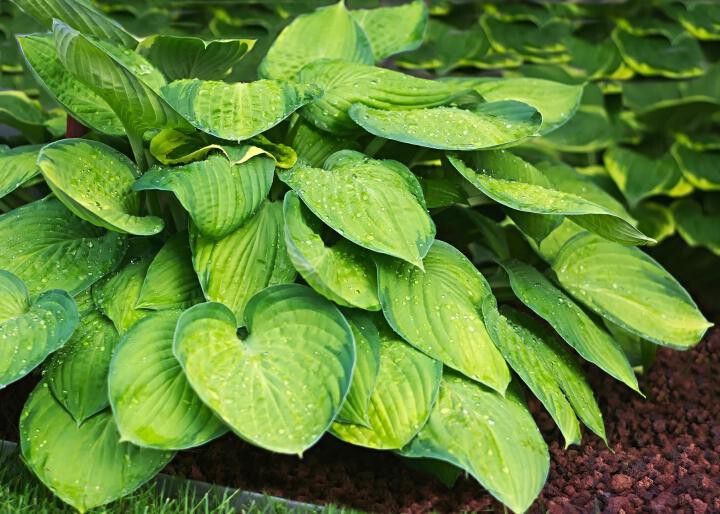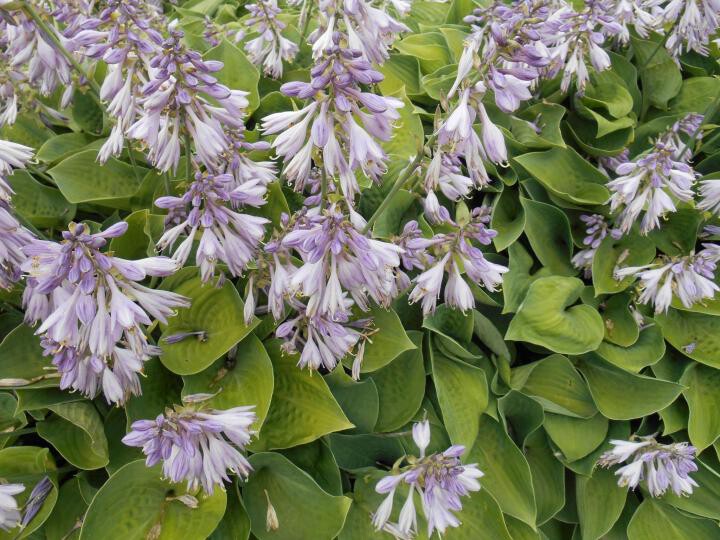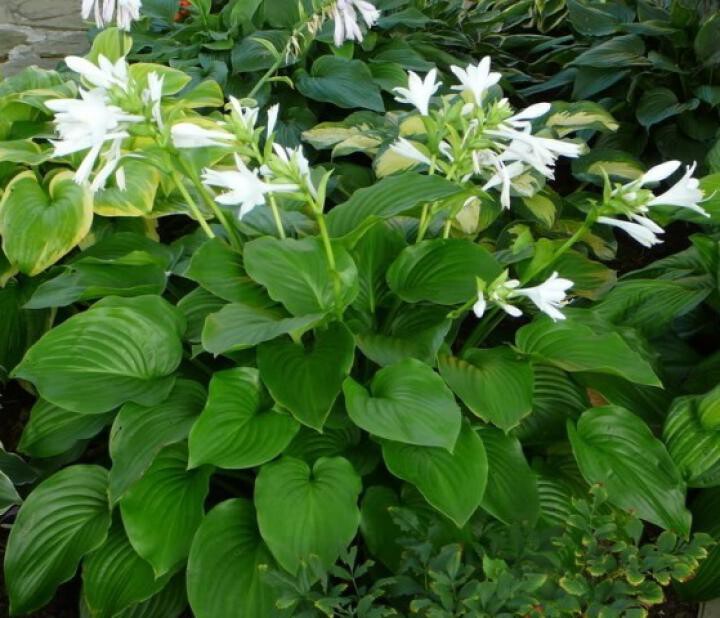Hostas are hardy perennials that are especially perfect for a garden that doesn’t get too much sun. Reliable and easy to grow, hostas are long-lived—and may even outlive the gardener! Plant in the spring and cut back in the fall after a few frosts. Learn more about growing and caring for hostas.
ABOUT HOSTAS
What’s neat about hostas is that there are so many sizes, heights, textures, and colors to work with! They fit into so many different kinds of gardens (patio, border, container, rock, shade) and are cold-hardy, too.
Most varieties tend to have a spread and height of between 1 and 3 feet, but larger or smaller varieties are readily available. Leaf colors include variegated white, lime green, and blue-green, to name just a few. The texture and shape of hosta leaves are also diverse, ranging from smooth and narrow to ridged and heart-shaped.
Though mainly known for their attractive foliage, the plants also produce lovely flowers from early summer to early fall in pink, lavender, light blue, or white. Hummingbirds and other pollinators love the flowers, and the flowers may even be fragrant, depending on variety.
Note: Slugs, snails, rabbits, and especially deer like hostas almost as much as people do. Keep this in mind if you have deer regularly wandering into your garden, as they will readily graze a hosta patch down to just stems.
PLANTING
WHEN TO PLANT HOSTAS
Buy hostas as dormant, bare-root divisions or potted plants in the spring.
Hostas can be planted later in the growing season, but will need extra attention (mostly watering) to ensure that they do not succumb to summer heat.
CHOOSING AND PREPARING A PLANTING SITE
Hostas do best in partial sun or dappled shade, but will do fine in deep shade, too.
Hostas’ large leaves do not lend themselves well to intense full sun, but if kept in fertile soil, they can “take the heat.”
HOW TO PLANT HOSTAS
Set the plants in a planting hole with the crown of the plant even with the surrounding soil and the growing tips visible at the soil surface.
If buying potted hostas, plant them at the same soil level as in the pot.
Gently dampen the soil around the plants and water until soil is moist.

CARE
HOW TO CARE FOR HOSTAS
Apply a well-balanced, slow-release fertilizer after planting or when growth emerges in the spring.
Keep the soil moist but not wet.
Place mulch around the plants to help retain moisture.
Remove flower stalks after bloom to encourage new growth.
Many hosta cultivars have nice color in fall so let them thrive until they start to suffer from frosts.
In late fall, after a few frosts, hostas will flatten out and get mushy. We suggest cutting them back to avoid slug and disease issues. Clean up around the plants and remove brown leaves. However, if you run out of time, you could also wait to cut them back until spring.
Transplanting and dividing is best done in early spring when the leaves just begin to emerge.
TRANSPLANTING OR DIVIDING HOSTAS
Hostas do not usually need dividing for their health. If they have less space, they’ll simply grow less quickly. However, if you wish to divide a hosta for a neater appearance, it’s best to do so in early spring once the ‘eyes’ or growing tips start to emerge from the ground. This is also a good time to move or transplant a hosta to a new site.
Leave as much of the root attached as possible to each crown or plant. Plant the new hostas at the same soil level as they were previously. Water well until established.
PESTS/DISEASES
Slugs and snails: If you see irregular holes along the leaf’s edges or entire leaves chewed off at the stem nocturnal slugs may be the culprit. Look for shiny slime trails on the leaves or on the ground around the plants.
Deer: It’s true: deer love hosta. To discourage deer, use fencing or motion-sensitive sprinklers. Speak to your local garden center about odor-based sprays and deer repellents; the deer will taste the distasteful repellent first. Here’s an example.
Rabbits: If you see clean-cut chew marks on young hosta stems and leaves you may have rabbits in your garden. Look for dropped leaves and rabbit droppings on the ground and around the plants.
RECOMMENDED VARIETIES
Once you start exploring hostas, you’ll find they get rather addictive! From 4-inch miniature hostas to 6-foot-wide giant hostas, there’s a hosta variety to fit any situation from large borders to tiny rock gardens. Here are just a few:
H. fotunei ‘Aureo Marginata’: Deep-green oval leaves accented by a golden edge.

H. x ‘Blue Cadet’: A small hosta with heart-shaped, bluish leaves. It makes for a nice edging plant. In mid-summer it blooms with mauve-blue flowers.

For sunnier spots, select plants from the Hosta plantaginea group. These plants also tend to have fragrant flowers in late summer. ‘August Moon’, ‘Honeybells’, and ‘Sum and Substance’ are a few of the varieties in this category.

WIT & WISDOM
Young hosta leaves are edible. Known as urui in Japan, they’re commonly boiled, fried in tempura, or eaten raw. The flavor is similar to lettuce and asparagus.
If you wish to remove your hostas, cut off the leaves to the ground and then dig out the crown located just below ground level. Pour vinegar or boiling water over the plant. If you have a larger area of hostas that you want to remove, cut the leaves off, remove the crowns and then cover the area with black plastic for the rest of the growing season.